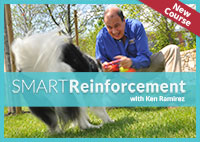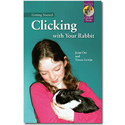The strategy in taming shy or feral rabbits is to associate all good things in life with you. All privileges, like time in the exercise pen, all toys, and all treats are accessed only through you. The rabbits' cage should contain only a litter box with hay, food bowl, water bowl, mat, and a chewing toy. Of course, this means that during the course of any 24-hour period, you should offer several sessions during which the rabbit does have access to an interesting—and rewarding, if challenging—activity. Ideally, the steps outlined below would be undertaken in a one- or two-week period, the length of which should be most strongly influenced by the speed with which the rabbit is able to work and how much time you are able to devote to training.

We use a clicker to mark "tame rabbit" behaviors that we then reinforce with something the rabbit desires, usually a food treat. The click marks the behavior and lets the rabbit know that a reward will be forthcoming. Clicks should be delivered just before or at the moment of the desired behavior. If you consistently click after the desired behavior, you will reinforce the behavior that follows the actual behavior that you want. For example, if you want the rabbit to take food from your hand, you have to click on the approach or at the moment the lips touch the food, not when the rabbit is running away with the pellet. So it is better to click as the rabbit approaches you, which at least is a component of the desired behavior of approaching and accepting food.
Timing is important. The game should move quickly to keep the rabbit's interest and in the case of shy/feral rabbits to keep them too busy to think about whether they should be scared. Treats should be delivered within about five seconds after the click. You should try to deliver about 30 treats per minute. Treats should be bite-sized in order for the game to move along quickly. Even a long rabbit pellet may be a little large: break it in half if needed. Prior to the training session, sit down and prepare about 15 bite sized treats. If you are feeding a long vegetable, allow the rabbit to take a bite and then REMOVE the vegetable from the pen while the rabbit is chewing.
Cues
As a behavior becomes established, you can add a verbal cue. To add a cue, select one word to associate with one behavior. When the rabbit performs the behavior, say the word and click and treat. After you have done this for some time, begin to say the word before the behavior and click and treat when you get the behavior. Each cue can relate to only one behavior. One behavior can have more than one cue.
Confidence building and loading the click
- The click, by itself, will not have meaning until the rabbit associates it with a reward. To do so, you need to associate (or load) the clicker with the reward. The reward we are using is food. When the rabbit takes a bite, click. This will associate the sound of the click with food. Click each time the rabbit takes a bite. The next items 2, 3, 4, and 5 are a discussion of the ways in which you can get the rabbit to eat from your hand. We get back to clicker training in item 6.
- Hand feed any food the rabbit will eat. In most instances it will be long vegetables such as parsley, cilantro, parsley, kale, carrots, etc. A shy domestic rabbit may only recognize rabbit pellets as food. If one food does not work, try another. Try to feed up to 50% of the rabbit's diet by hand. Plan on several short sessions each day.
- Hold the food pointing toward the floor with your wrist bent and the back of your hand at a level above the bunny's head. This position allows you to convert to a pet later. If the rabbit seems nervous about the hand position, use a long food and hold it so that it points toward the rabbit. Your hand and the food will form a >. You may need to point the food toward the rabbit.
- If the rabbit will not eat from your hand you may find that sitting with your side to the bunny and your face averted will increase the rabbit's confidence. Sometimes feeding through the cage wire will be more acceptable to the rabbit, especially if the rabbit only recognizes pellets as food. If you are feeding through the wire, feed through the closed cage door. This positions the rabbit to eat from your hand at the open door later. Do not underestimate the power of a favorite food. If one food does not work, try another. If you are not sure that the rabbit knows an item is food, place a piece in the food bowl a couple of days in a row and once it has been eaten, try feeding it by hand.
- As the rabbit eats more confidently from your hand, shorten the length of the food items by breaking off increasingly shorter lengths of the foods. A carrot can be chopped into about 200 pea-size pieces. If you are feeding through cage wire, offer some of the food items through the open door.
- Call the rabbit's name and click as the rabbit moves toward the food item.
- If the rabbit suffers a crisis of confidence, increase the length of your food items or close the cage door. Shorten the food items a little more rapidly this time. If you have closed the cage door, try one or two short sessions with the door closed and open it again. It will help to schedule your open door session for the first meal of the day, when the rabbit is most hungry.
- Use bonuses. At the end of sessions give the rabbit several pieces of food, so that the end of training is not seen as a punishment. If you find that the rabbit is having a bad session, click and give several pieces of food for a desired behavior or a behavior close to a desired behavior. This use of a bonus keeps the rabbit from becoming discouraged. Give a bonus after a click when the rabbit makes big progress in performance or learns a new behavior, to impress on the rabbit that this is definitely a behavior worth remembering. Every few sessions, give a bonus just to keep the rabbit's interest.
Target training
- When the rabbit is actively interested in your approach, begin target training. Hold your loosely-closed hand two to three inches away from the rabbit's head. Click and treat when he looks or moves toward it. Deliver the treat within five seconds of the click. Place your hand in different locations, to the left and right of the nose, above the nose, below the nose. Vary the pattern.
- Work on this, gradually raising the standard, until the rabbit is touching your hand with its nose in order to earn the click and treat.
- Add the cue "touch." At first, say the word when the rabbit is touching your hand; after a few sessions say the cue before the rabbit touches your hand, then click and treat.

Hand training
- When the rabbit is confidently touching your hand for a treat, try nudging the rabbit with your hand as it touches you, turning the rabbit's touch into a gentle pet. Click as you do so and treat. The rabbit may retreat at the touch. Use the treat to return the rabbit to the desired training spot. (Click for behavior, feed for location).
- Put some food in your hand and gently pet the rabbit as it is eating; click and treat. If it backs off, close your hand. Open your hand when the rabbit touches your hand again and continue trying to pet the rabbit.
- Mix touching the rabbit with the rabbit touching a target and click and treat each time. Gradually increase the ratio of you touching the rabbit to the ratio of the rabbit touching you.
- Try a variety of touches with the rabbit, followed by a click and treat. Touches to the rear, side, back, and shoulders may be more acceptable at first. When a certain touch becomes pleasurable to the rabbit, it can be used in lieu of food as a reward for a less pleasurable pat. In this case the click and treat would become a click and pat. Increase the length and pressure of the touch. Turn a touch into a longer and longer pat and click and treat. Turn a shoulder touch into a scruff hold and click and treat. Add touches to the ears, belly, head, and feet followed by click and treat. Remember that each touch earns a click and treat.
- If the rabbit becomes stressed, allow it to touch your hand for click and treat until it is confident, and then try touching it again.
- If you progress too fast your rabbit may let you know by lunging, growling, attacking, or simply hopping away. Some rabbits won't accept treats when stressed. Don't reward aggressive behavior. Any aggressive behavior stops the game. Remove your hand and all those yummy treats and turn your back on the rabbit. Count to 10, take a deep breath, and try again. You may have to go back a few steps and regain your rabbit's trust. End training sessions on a successful note even if, to do so, you need to go back to an earlier behavior the rabbit learned.
Lifting
- When the rabbit seems very confident about being touched all over and allows you to hold it by the scruff, say "lift," and lift it about 1" from the floor and click. Say "down" and as you are placing it on the floor, click. Follow with a bonus. Do not place the rabbit on the floor while it is struggling. If the rabbit struggles after you say "down" and begin lowering, stop. Wait until the rabbit is still, click, and resume lowering. Treat when the rabbit is on the ground.
- Add the occasional lift, click, and treat to each training session. Work on increasing the length of the lift and then the height.
- Start rotating your body during the lift so that the rabbit is outside the cage briefly before you click and treat and return it to the cage floor.
- It may be helpful for some rabbits to work on lifting exercises on a small table. Be prepared to reassure your bunny, with treats and pats, the first time it is on the table. Do not let your rabbit jump off the table on its own.
Pen work
- When the rabbit is comfortable being petted and lifted in the cage, you can begin training it in a pen. It generally takes about three days of training in a cage for the rabbit to be confident about being handled. Gently lift your rabbit and place it in a small, secure pen. A 4' by 4' dog exercise pen is ideal. Add a laundry basket with cut-out sides or cardboard box with doors for the rabbit to climb on or crawl under. Add a litter box if necessary.
- Learned behaviors need to be re-learned in each new location. The learning curve in a new location will be faster than the original learning curve, but it is a learning curve nevertheless. Start with the earliest behaviors that the rabbit learned and move through all the behaviors as fast as you can until the rabbit is up to speed.
- Practice hand targeting in the pen. The rabbit may ignore you until it gets used to the new area. Click and treat for the rabbit approaching you. Add the rabbit's name to the touch cue and move around the outside of the pen clicking and treating as the rabbit seeks you out and touches your hand.
- Enter the pen and sit down. Click and treat for the rabbit making any physical contact with you. Don't try to touch the rabbit until it is confidently touching you.
- Practice as many of the hand-training exercises above as the rabbit is comfortable with.
- At this point you can start training silly tricks. Click and treat for the rabbit jumping on the box, standing up on its hind legs, jumping over your legs, putting its paws on you or anything adorable that your rabbit likes to do. Work on no more than one or two new tricks a session. After the rabbit is rewarded for doing a behavior a few times and seems to know that you will click when the behavior occurs, you can add a verbal cue as the rabbit does its trick. Gradually say the cue sooner until the cue occurs before the behavior. You can also use hand motions as cues to let the rabbit know what you want it to do.
- Alternate between pen exercises 4 and 5. Some rabbits are going to be less interested in being petted in the pen, but may still want to play the clicker game and earn treats by doing tricks. Many rabbits seem more comfortable being petted when they are eating on top of the box. (Go figure).
- Don't leave the rabbit alone in the pen for more than a few minutes. Keep the first few pen sessions to around 15 minutes. When you are done, gently lift the rabbit and return it to the cage and give it a big reward.
- Increase the length of the pen training sessions as the rabbit becomes reliable about coming when called, accepting pats, being lifted, and doing silly tricks on cue. The size of the pen can also be increased at this time and more toys added.
- If the tame behavior breaks down, which can happen if the rabbit is frightened by being grabbed, chased, etc., go backward in the training to where the rabbit is confident, and work forward again as quickly as possible. These "tune-up" sessions usually take a fraction of the time that the original taming sessions took.
Generalizing new behaviors
- When the bunny is able to do most behaviors on cue, you can move the pen to a different location. Be prepared to relax your standards or start from the beginning when the environment changes. After training in a few different places, the rabbit will be able to transfer its new behaviors to other locations. You can help a rabbit to feel more comfortable in a new setting by training it on a blanket or mat, and moving the blanket or mat to each new location.
- Switch trainers if possible so the rabbit will know that there are many people who can play the clicker game and can be trained to dispense treats. Start fading the clicker for the tricks the rabbit has learned well. Substitute a word such as "yes" or "good bunny" for some of the clicks. Continue to give the rabbit food rewards each time it does a trick. Gradually decrease the use of the clicker until you are not using it at all for established behaviors. Substitute pats and praise for some of the food rewards. Continue using the clicker to train new behaviors.
Mimicking behaviors
- Rabbits learn by watching other rabbits. If you have a clicker-wise rabbit or a rabbit that is very comfortable with being handled, you can use it to engage a new rabbit. Simply allow the new rabbit to watch while the clicker-wise bunny is being trained. Often the new rabbit will volunteer to play "the clicker game." It can really speed up the first session.
- As you train new behaviors, allow more experienced rabbits to demonstrate within the view of a new bunny. For example, cue and lift a bunny that is very confident with the lift in front of your new rabbit, just before you attempt a lift with the new rabbit. It can be very calming for the new rabbit.
For additional reading: Don't Shoot the Dog by Karen Pryor: This book will give you the basics of operant conditioning. It covers marking behaviors, adding cues, etc. Really an important book. Ruff Love, by Susan Garrett: This is a book about working with behavior-challenged dogs. From it we took some of the basics of this approach. Read Karen's book first.







Post new comment